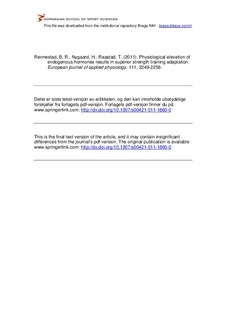| dc.contributor.author | Rønnestad, Bent R. | |
| dc.contributor.author | Nygaard, Håvard | |
| dc.contributor.author | Raastad, Truls | |
| dc.date.accessioned | 2012-04-11T10:52:29Z | |
| dc.date.available | 2012-04-11T10:52:29Z | |
| dc.date.issued | 2011 | |
| dc.identifier | Seksjon for fysisk prestasjonsevne / Department of Physical Performance | |
| dc.identifier.citation | European Journal of Applied Physiology. 2011, 111(9), 2249-2259 | no_NO |
| dc.identifier.issn | 1439-6327 | |
| dc.identifier.issn | 1439-6319 | |
| dc.identifier.uri | http://hdl.handle.net/11250/170906 | |
| dc.description | I Brage finner du siste tekst-versjon av artikkelen, og den kan inneholde ubetydelige forskjeller fra forlagets pdf-versjon. Forlagets pdf-versjon finner du på www.springerlink.com: http://dx.doi.org/10.1007/s00421-011-1860-0 / In Brage you'll find the final text version of the article, and it may contain insignificant differences from the journal's pdf version. The original publication is available at www.springerlink.com: http://dx.doi.org/10.1007/s00421-011-1860-0 | no_NO |
| dc.description.abstract | The purpose of this study was to determine the influence of transiently elevated endogenous hormone concentrations during exercise on strength training adaptations. Nine subjects performed four unilateral strength training session per week on the elbow flexors for 11 weeks. During two of the weekly sessions, leg exercises were performed to acutely increase the systemic anabolic hormone concentration immediately before the exercises for one of the elbow flexors (L + A). On the two other weekly training sessions, the contralateral elbow flexors were trained without prior leg exercises (A). By randomizing one arm of the subjects to serve as a control and the other as experimental, both conditions have the same nutritional and genetic environment. Serum testosterone and growth hormone was significantly increased during the L − A training session, while no hormonal changes occurred in the A session. Both A and L + A increased 1RM in biceps curl, peak power in elbow flexors at 30 and 60% of 1RM, and muscle volume of the elbow flexors (p < 0.05). However, only L + A achieved increase in CSA at the part of the arm flexors with largest cross sectional area (p < 0.001), while no changes occurred in A. L + A had superior relative improvement in 1RM biceps curl and favorable muscle adaptations in elbow flexors compared to A (p < 0.05). In conclusion, performing leg exercises prior to arm exercises, and thereby increasing the levels of serum testosterone and growth hormone, induced superior strength training adaptations compared to arm training without acute elevation of hormones. | no_NO |
| dc.language.iso | eng | no_NO |
| dc.publisher | Springer | no_NO |
| dc.subject | plasma testosterone | no_NO |
| dc.subject | growth hormone | no_NO |
| dc.subject | 1RM | no_NO |
| dc.subject | peak power | no_NO |
| dc.title | Physiological elevation of endogenous hormones results in superior strength training adaptation | no_NO |
| dc.type | Journal article | no_NO |
| dc.type | Peer reviewed | no_NO |
| dc.subject.nsi | VDP::Mathematics and natural science: 400::Basic biosciences: 470 | no_NO |
| dc.source.pagenumber | 2249-2259 | no_NO |
| dc.source.volume | 111 | no_NO |
| dc.source.journal | European Journal of Applied Physiology | no_NO |
| dc.source.issue | 9 | no_NO |
